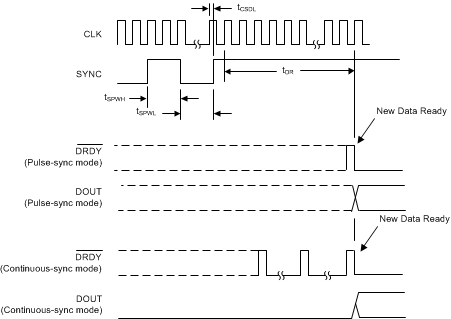ZHCSIU4A September 2018 – August 2019 ADS1284
PRODUCTION DATA.
- 1 特性
- 2 应用
- 3 说明
- 4 修订历史记录
- 5 Pin Configuration and Functions
- 6 Specifications
- 7 Parameter Measurement Information
-
8 Detailed Description
- 8.1 Overview
- 8.2 Functional Block Diagram
- 8.3 Feature Description
- 8.4
Device Functional Modes
- 8.4.1 Synchronization (SYNC PIN and SYNC Command)
- 8.4.2 Reset (RESET Pin and Reset Command)
- 8.4.3 Master Clock Input (CLK)
- 8.4.4 Power-Down (PWDN Pin and STANDBY Command)
- 8.4.5 Power-On Sequence
- 8.4.6 DVDD Power Supply
- 8.4.7 Serial Interface
- 8.4.8 Data Format
- 8.4.9 Reading Data
- 8.4.10 One-Shot Operation
- 8.4.11 Offset and Full-Scale Calibration Registers
- 8.4.12 Calibration Commands (OFSCAL and GANCAL)
- 8.4.13 User Calibration
- 8.5
Programming
- 8.5.1
Commands
- 8.5.1.1 SDATAC Requirements
- 8.5.1.2 WAKEUP: Wake-Up From Standby Mode
- 8.5.1.3 STANDBY: Standby Mode
- 8.5.1.4 SYNC: Synchronize the Analog-to-Digital Conversion
- 8.5.1.5 RESET: Reset the Device
- 8.5.1.6 RDATAC: Read Data Continuous
- 8.5.1.7 SDATAC: Stop Read Data Continuous
- 8.5.1.8 RDATA: Read Data by Command
- 8.5.1.9 RREG: Read Register Data
- 8.5.1.10 WREG: Write to Register
- 8.5.1.11 OFSCAL: Offset Calibration
- 8.5.1.12 GANCAL: Gain Calibration
- 8.5.1
Commands
- 8.6
Register Maps
- 8.6.1
Register Descriptions
- 8.6.1.1 ID_CFG: ID_Configuration Register (address = 00h) [reset =x0h]
- 8.6.1.2 CONFIG0: Configuration Register 0 (address = 01h) [reset = 52h]
- 8.6.1.3 CONFIG1: Configuration Register 1 (address = 02h) [reset = 08h]
- 8.6.1.4 HPF0 and HPF1 Registers
- 8.6.1.5 OFC0, OFC1, OFC2 Registers
- 8.6.1.6 FSC0, FSC1, FSC2 Registers
- 8.6.1
Register Descriptions
- 9 Application and Implementation
- 10器件和文档支持
- 11机械、封装和可订购信息
8.4.1.1 Pulse-Sync Mode
In pulse-sync mode, the ADS1284 unconditionally synchronizes by stopping and restarting the conversion process. Synchronization is possible by pin or command in this mode. At synchronization, the device resets the internal filter memory, DRDY goes high, and after the digital filter has settled, new conversion data are available as shown in Figure 53 and Table 14 (Pulse-sync mode).
 Figure 53. Pulse-Sync and Continuous-Sync Timing With Single Synchronization
Figure 53. Pulse-Sync and Continuous-Sync Timing With Single Synchronization Table 14. Pulse-Sync Timing for Figure 53 and Figure 54
| PARAMETER | MIN | MAX | UNIT | |
|---|---|---|---|---|
| tCSDL | CLK rising edge to SYNC rising edge(2) | 30 | –30 | ns |
| tSYNC | SYNC clock period(1) | 1 | Infinite | n / fDATA |
| tSPWH, L | SYNC pulse width, high or low | 2 | 1 / fCLK | |
| tDR | Time for data ready (SINC filter) | See Table 15 | ||
| Time for data ready (FIR filter) | 62.98046875 / fDATA + 468 / fCLK | |||
Table 15. tDR Time for Data Ready (Sinc Filter)
| fDATA (kSPS) | fCLK CYCLES(1) |
|---|---|
| 128 | 440 |
| 64 | 616 |
| 32 | 968 |
| 16 | 1672 |
| 8 | 2824 |
Table 15 is referenced by Table 14 and Table 17.
Observe the timing restriction of SYNC rising edge to CLK rising edge as shown in Figure 53 and Table 14. Synchronization occurs on the next rising CLK edge after the rising edge of the SYNC, or after the eighth rising SCLK edge when synchronized by command. To synchronize multiple ADCs by the sync command, broadcast the command to the ADCs simultaneously.